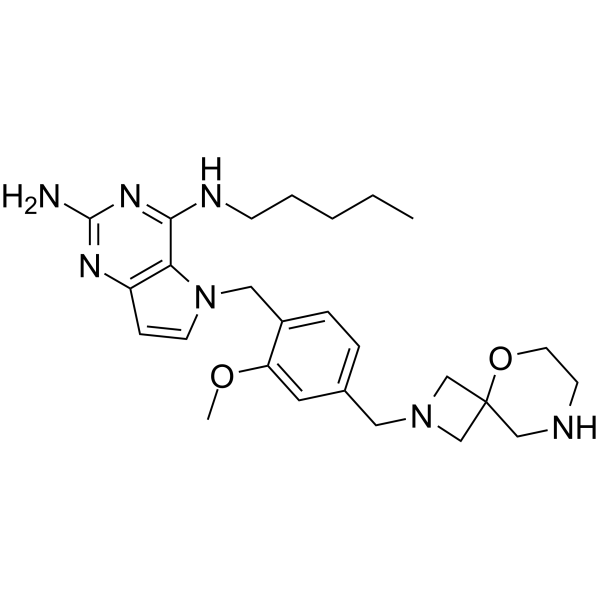| In Vitro |
TLR7/8 agonist 7 (compound 10) (0-5 μΜ; 24 h) is a TLR7 agonist and shows selectivity to TLR7[1]. TLR7/8 agonist 7 (compound 10) (0-1 μΜ; 120 h) shows no cytotoxicity to KB cells[1]. TLR7/8 agonist 7 (compound 10) (0.01, 0.1, 1, 10, 100 and 1000 nM; 48 h) induces immune cells activation[1]. TLR7/8 agonist 7 (compound 10) (0.1, 1, 10, 100 and 1000 nM; 24 and48 h) induces cytokine release[1]. Cell Viability Assay[1] Cell Line: HEK293-humanTLR7 (hTLR7), HEK293-mouseTLR7 (mTLR7) and HEK293-humanTLR8 (hTLR8) cell lines Concentration: 1:4 serial dilution starting from 5 μΜ Incubation Time: 24 h Result: Showed selectivity to TLR7 and TLR8 as an agonist with EC50 of 1.5, 341.7 and 3.7nM in hTLR7, hTLR8 and mTLR7 respectively at 24 h. Cell Cytotoxicity Assay[1] Cell Line: KB cells Concentration: 1:4 serial dilution starting from 1000 nM Incubation Time: 120 h Result: Exhibited no cytotoxicity to KB cells though until concentration up to 1 μΜ. Cell Viability Assay[1] Cell Line: Human peripheral blood mononuclear cells (PBMCs), cyno PBMCs and mouse splenocytes Concentration: 0.01, 0.1, 1, 10, 100 and 1000 nM Incubation Time: 48 h Result: Activated immune cells (monocyte, B cell, and DCs) in human PBMCs, cyno PBMCs and mouse splenocytes. Cell Viability Assay[1] Cell Line: Human peripheral blood mononuclear cells (PBMCs), cyno PBMCs and mouse splenocytes Concentration: 0.1, 1, 10, 100 and 1000 nM Incubation Time: 24 and 48 h Result: Stimulated IL-6 , MCP-I , and ILlRa release from human PBMCs, IL-6 and MCP-I release from cyno PBMCs, as well as IL-6 , MCP-I , TNFa and IP-10 release from mouse splenocytes.
|
